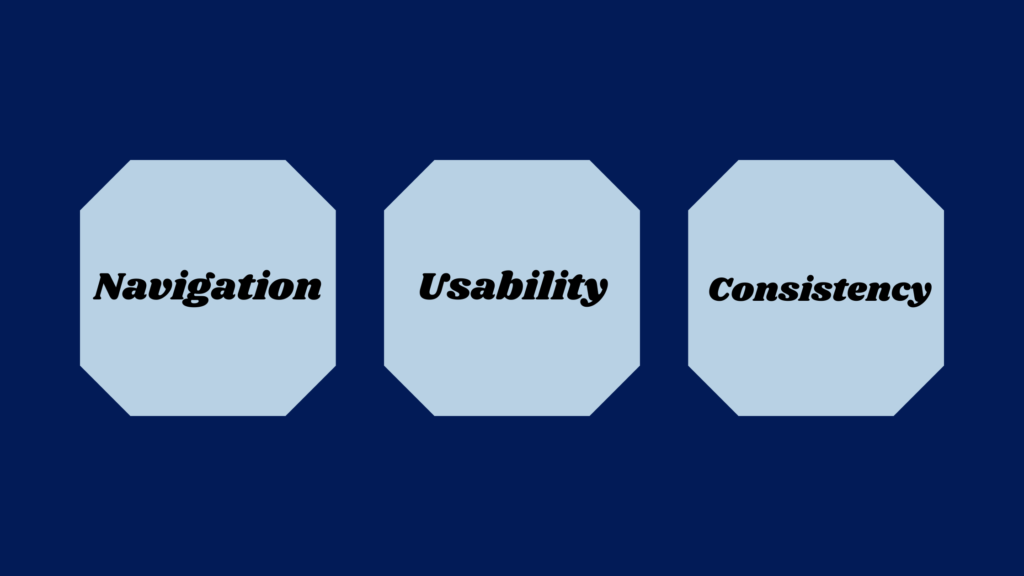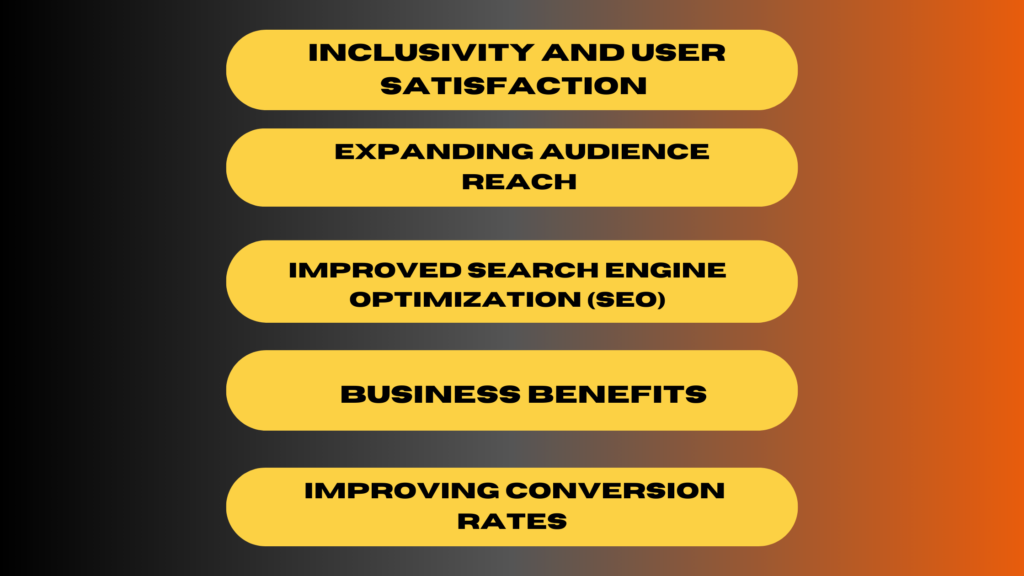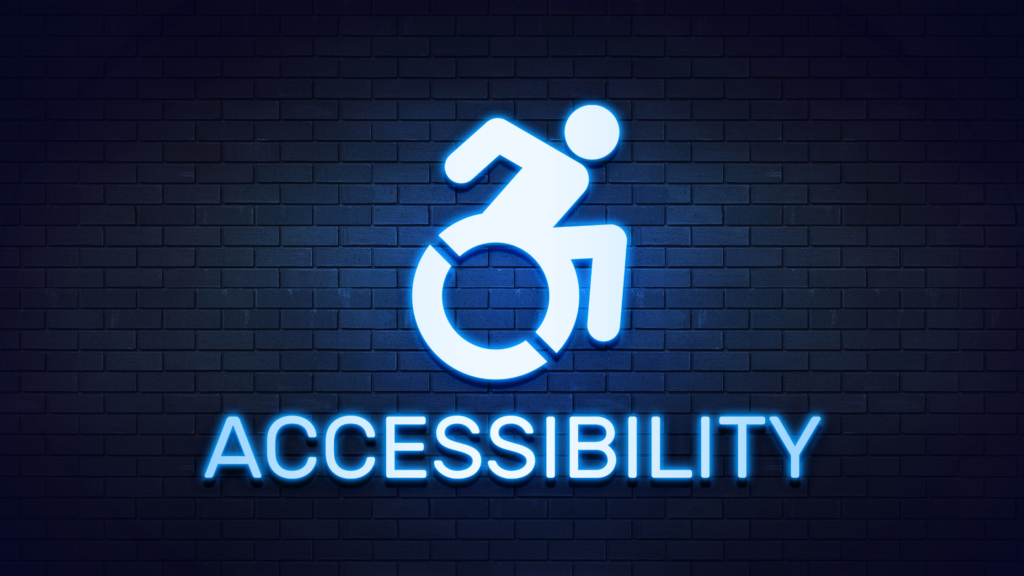Importance Of Top 10 Web Accessibility

Web accessibility means that websites, tools, and technologies are designed and developed so that people with disabilities can use them. More specifically, people can perceive, understand, navigate, and interact with the Web contribute to the Web. Web accessibility encompasses all disabilities that affect access to the Web, including:
- auditory
- cognitive
- neurological
- physical
- speech
- Visual
Accessibility is a broad term that encompasses many different aspects of a website. It’s important to keep in mind that accessibility isn’t just about making sure people with disabilities can use your site, it’s also about making sure everyone else can as well.
Here are some things to think about when considering accessibility:

Navigation – your website should be easy for visitors to navigate through. You don’t want them getting lost or confused by anything on your site, so make sure everything has an obvious name and function. If there are multiple ways into content (links, menus, etc.). Be sure they’re clearly labelled so users know where they’ll end up if they click somewhere new.
Usability – This includes making sure things like buttons work properly when clicked or tapped – otherwise users won’t get the experience you want them to.
By prioritizing web accessibility, you can ensure all of your visitors — regardless of ability — have a seamless experience on your website. Unfortunately, many sites don’t comply with web accessibility best practices and guidelines. For users with disabilities, a site that doesn’t comply is difficult or downright impossible to use.
The World Health Organization (WHO) estimates that 16% of the global population has a disability, so your site must serve as many people as possible.
What kinds of disability are we looking at?
People with disabilities are just as diverse as people without disabilities, and so are their disabilities. The key lesson here is to think beyond your own computer and how you use the web, and start learning about how others use it — you are not your users. The main types of disability to consider are explained below, along with any special tools they use to access web content (known as assistive technologies, or ATs).
Note: The World Health Organization’s Disability and health fact sheet states that “Over a billion people, about 15% of the world’s population, have some form of disability”, and “Between 110 million and 190 million adults have significant difficulties in functioning.”
- Hearing lossDeafness and difficulty hearing are auditory disabilities that are considered when checking a website for accessibility.
- Visual impairmentThis category includes blindness and partial sight. People with visual impairments may have difficulty seeing clearly or perceiving color contrast ratios.
- Learning disabilityPeople with learning disabilities may be often assumed to be less intelligent or not need tech features like those without disabilities.
- Intellectual disabilitiesThese disabilities can make it difficult to learn, retain information, and communicate.
- DyslexiaThis disability is often considered hidden because it’s not always visible and people with dyslexia may not be aware they have it.
Note: The World Health Organization’s Disability and health fact sheet states that “Over a billion people, about 15% of the world’s population, have some form of disability”, and “Between 110 million and 190 million adults have significant difficulties in functioning.”
Importance of Accessible website

1) Inclusivity and User Satisfaction
One of the primary reasons to prioritize web accessibility is to foster inclusivity. Every individual, regardless of their abilities, deserves equal access to information and services provided online. By making websites accessible, we empower everyone to participate fully in the digital realm, whether it’s browsing content, making purchases, or engaging with online communities.
2) Expanding Audience Reach
One of the most significant benefits of accessible website design is the ability to reach a broader audience. According to global statistics, over a billion people live with some form of disability, including visual, auditory, cognitive, and motor impairments. When websites are designed with accessibility in mind, they become usable by this large segment of the population. By excluding accessibility features, businesses may inadvertently alienate potential users or customers, missing out on opportunities to expand their reach and impact.
3) Improved Search Engine Optimization (SEO)
Accessible websites are optimized for search engines, which can improve your website’s ranking and visibility. Features such as descriptive alt text and clear headings can help search engines understand your site’s content, leading to better search results.
To ensure your website is accessible, it is important to follow accessibility standards, such as the Web Content Accessibility Guidelines (WCAG). These guidelines provide specific recommendations for making your website accessible, including design, content, and technology guidelines.
Accessibility is an essential aspect of website design that should not be overlooked. Investing in accessibility will benefit not only those with disabilities but everyone who visits your site. By designing an accessible website, you can reach a wider audience, improve the user experience, and enhance your SEO efforts.
4) Business Benefits
Incorporating accessibility into the development process benefits businesses aiming to differentiate themselves. A website that accommodates all web users aligns with your brand’s commitment to inclusivity and enhances your company’s reputation. This approach benefits SEO, as search engines prefer websites that serve a wider audience and foster innovation by incorporating a variety of perspectives in the design process.
5) Legal Compliance and Ethical Responsibility
Many countries have enacted laws and regulations that mandate website accessibility, such as the Americans with Disabilities Act (ADA) in the United States and the European Union’s Web Accessibility Directive. Non-compliance with these regulations can lead to legal consequences, including fines and lawsuits. However, beyond the legal implications, there is an ethical responsibility to ensure that the internet is accessible to everyone. Designing with accessibility in mind demonstrates a commitment to inclusivity and social responsibility, which can positively impact a brand’s reputation and foster trust among users.
6. Improving Conversion Rates
Accessible websites are not only inclusive but also effective in driving conversions. When users can easily navigate and interact with a website, they are more likely to take desired actions, such as making a purchase, signing up for a newsletter, or filling out a contact form. Barriers to accessibility, such as complex navigation or unclear instructions, can frustrate users and lead to lost opportunities. By ensuring that your website is accessible, you create a smoother, more satisfying experience that can lead to higher conversion rates and increased customer satisfaction.
Moreover, accessibility directly impacts user satisfaction. A website that is challenging or impossible to navigate for users with disabilities can result in frustration, exclusion, and ultimately, loss of potential customers or readership. Conversely, an accessible website provides a seamless and enjoyable experience for all users, enhancing engagement and loyalty.
When working on your custom WordPress Website services, it’s vital to prioritize accessibility. Accessible websites tend to perform better in search engines, as they are easier for bots to crawl and index. Moreover, an accessible website can lead to better user engagement and satisfaction, as it caters to a broader audience.

Conclusion:
Accessibility in website design is not just a moral and legal obligation but a crucial aspect of creating inclusive digital experiences. By prioritizing accessibility, businesses can reach a broader audience, enhance user satisfaction, and foster a more inclusive online environment. Implementing accessible design principles ensures that all users, regardless of their abilities, can navigate, interact with, and benefit from online content, ultimately contributing to a more equitable digital landscape.


It is actually a nice and helpful piece of info.
I am glad that you simply shared this helpful information with us.
Please keep us up to date like this. Thank you for sharing.!
Hey! Do you know if they make any plugins to help with SEO?
I’m trying to get my blog to rank for some targeted keywords but I’m not
seeing very good gains. If you know of any please share. Thank
you! You can read similar article here: Wool product
Hi! Do you know if they make any plugins to help with SEO?
I’m trying to get my blog to rank for some
targeted keywords but I’m not seeing very good results.
If you know of any please share. Cheers!
You can read similar art here: Eco bij
Individuals ought to carry out progressive muscle relaxation in a cushty place.
sugar defender ingredients
Adding Sugar Defender to my daily regimen was just one of the most effective choices
I’ve produced my health and wellness. I beware
concerning what I eat, however this supplement adds an extra layer of assistance.
I really feel more stable throughout the day, and my food cravings
have lowered dramatically. It’s nice to have something so basic that makes such a big difference!